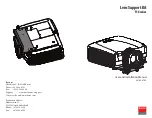
28
Figure 5-3
The emblem on the end of
the focus knob shows the
correct rotational direction
for focusing the CPC
.
the primary mirror only slightly. Therefore, it will take many turns (about 30) to go from close focus (approximately 60 feet) to
infinity.
For astronomical viewing, out of focus star images are very diffuse, making them difficult to
see. If you turn the focus knob too quickly, you can go right through focus without seeing
the image. To avoid this problem, your first astronomical target should be a bright object
(like the Moon or a planet) so that the image is visible even when out of focus. Critical
focusing is best accomplished when the focusing knob is turned in such a manner that the
mirror moves against the pull of gravity. In doing so, any mirror shift is minimized. For
astronomical observing, both visually and photographically, this is done by turning the focus
knob counterclockwise.
C
C
a
a
l
l
c
c
u
u
l
l
a
a
t
t
i
i
n
n
g
g
M
M
a
a
g
g
n
n
i
i
f
f
i
i
c
c
a
a
t
t
i
i
o
o
n
n
You can change the power of your telescope just by changing the eyepiece (ocular). To
determine the magnification of your telescope, simply divide the focal length of the
telescope by the focal length of the eyepiece used. In equation format, the formula looks
like this:
Focal
Length
of
Telescope
(mm)
Magnification =
⎯⎯⎯⎯⎯⎯⎯⎯⎯⎯⎯⎯⎯⎯
Focal
Length
of
Eyepiece
(mm)
Let’s say, for example, you are using the 40mm Plossl eyepiece. To determine the magnification you simply divide the focal
length of your telescope (the CPC 8 for example has a focal length of 2032mm) by the focal length of the eyepiece, 40mm.
Dividing 2032 by 40 yields a magnification of 51 power.
Although the power is variable, each instrument under average skies has a limit to the highest useful magnification. The general
rule is that 60 power can be used for every inch of aperture. For example, the CPC 8 is 8 inches in diameter. Multiplying 8 by
60 gives a maximum useful magnification of 480 power. Although this is the maximum useful magnification, most observing is
done in the range of 20 to 35 power for every inch of aperture which is 160 to 280 times for the CPC 8 telescope.
D
D
e
e
t
t
e
e
r
r
m
m
i
i
n
n
i
i
n
n
g
g
F
F
i
i
e
e
l
l
d
d
o
o
f
f
V
V
i
i
e
e
w
w
Determining the field of view is important if you want to get an idea of the angular size of the object you are observing. To
calculate the actual field of view, divide the apparent field of the eyepiece (supplied by the eyepiece manufacturer) by the
magnification. In equation format, the formula looks like this:
Apparent Field of Eyepiece
True Field =
⎯⎯⎯⎯⎯⎯⎯⎯⎯⎯⎯⎯⎯
Magnification
As you can see, before determining the field of view, you must calculate the magnification. Using the example in the previous
section, we can determine the field of view using the same 40mm eyepiece. The 40mm Plossl eyepiece has an apparent field of
view of 46°. Divide the 46° by the magnification, which is 51 power. This yields an actual field of .9°, or almost a full degree.
To convert degrees to feet at 1,000 yards, which is more useful for terrestrial observing, simply multiply by 52.5. Continuing
with our example, multiply the angular field .9° by 52.5. This produces a linear field width of 47 feet at a distance of one
thousand yards. The apparent field of each eyepiece that Celestron manufactures is found in the Celestron Accessory Catalog
(#93685).
G
G
e
e
n
n
e
e
r
r
a
a
l
l
O
O
b
b
s
s
e
e
r
r
v
v
i
i
n
n
g
g
H
H
i
i
n
n
t
t
s
s
When working with any optical instrument, there are a few things to remember to ensure you get the best possible image.
•
Never look through window glass. Glass found in household windows is optically imperfect, and as a result, may vary in
thickness from one part of a window to the next. This inconsistency can and will affect the ability to focus your telescope.
In most cases you will not be able to achieve a truly sharp image, while in some cases, you may actually see a double image.
Summary of Contents for CPC 1100
Page 1: ...I IN NS ST TR RU UC CT TI IO ON N M MA AN NU UA AL L...
Page 58: ...58 APPENDIX E MAPS OF TIME ZONES...
Page 59: ...59...
Page 60: ...60...
Page 61: ...61...
Page 62: ...62...
Page 63: ...63...
Page 64: ...64...
Page 65: ...65...
















































